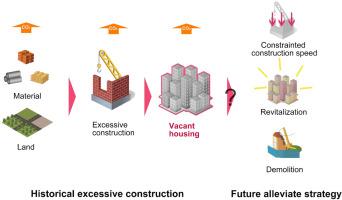Resource and the environmental burdens of excessive construction in China's urban housing sector
IF 10.9
1区 环境科学与生态学
Q1 ENGINEERING, ENVIRONMENTAL
引用次数: 0
Abstract
In China's complex urbanization process, excessive construction has led to large-scale housing vacancies, hindering the development of low-carbon and sustainable cities. This study proposes a three-layer accounting framework based on dynamic Material Flow Analysis (MFA). The framework innovatively identifies and quantifies the impacts of excessive construction on urban building metabolism and systematically evaluates five vacant housing disposal strategies across multiple dimensions, focusing on material consumption, land use, and carbon emissions. The results indicate that the excessive vacant housing stock in Chinese cities reached approximately 3986 km2 in 2024. If excessive vacant stock can be effectively revitalized, between 2025–2060, the total material consumption could be reduced by up to 3873 Mt and carbon emissions by 1241 Mt. However, historical excessive construction has significantly diminished the metabolic efficiency of urban housing, and even under the optimal strategy (revitalization), it remains challenging to fully offset the excessive resource inputs already incurred. Throughout the entire urban housing development period (2000–2060), conservative estimates suggest that at least 2200 Mt of ineffective material input and 1395 Mt of additional carbon emissions will be generated. Given that the existing housing stock is theoretically sufficient to meet demand through 2030, it is imperative for China to curb further expansion of the housing stock while actively advancing the revitalization of existing vacant units. Furthermore, with housing demand expected to peak around 2050, a large volume of vacant stock beyond that point may render revitalization strategies ineffective, necessitating more aggressive interventions such as proactive demolition.

中国城市住房部门过度建设的资源和环境负担
在中国复杂的城市化进程中,过度建设导致大量住房空置,阻碍了低碳可持续城市的发展。本研究提出一个基于动态物料流分析(MFA)的三层会计框架。该框架创新性地识别和量化了过度建设对城市建筑代谢的影响,并从材料消耗、土地利用和碳排放等多个维度对五种空置住房处置策略进行了系统评估。结果表明,2024年中国城市空置住房存量过剩约为3986 km2。如果能够有效盘活过剩的空置存量,2025-2060年期间,总材料消耗可减少38.73亿吨,碳排放可减少12.41亿吨。然而,历史上的过度建设已经显著降低了城市住房的代谢效率,即使在最优化的策略(振兴)下,要完全抵消已经产生的过度资源投入仍然是一个挑战。保守估计,在整个城市住房发展时期(2000-2060年),将至少产生22亿吨无效材料投入和1395亿吨额外碳排放。鉴于现有住房存量理论上足以满足到2030年的需求,中国必须遏制住房存量的进一步扩张,同时积极推进现有空置单元的振兴。此外,由于住房需求预计将在2050年左右达到峰值,届时大量空置库存可能会使振兴战略失效,因此需要更积极的干预措施,如主动拆除。
本文章由计算机程序翻译,如有差异,请以英文原文为准。
求助全文
约1分钟内获得全文
求助全文
来源期刊

Resources Conservation and Recycling
环境科学-工程:环境
CiteScore
22.90
自引率
6.10%
发文量
625
审稿时长
23 days
期刊介绍:
The journal Resources, Conservation & Recycling welcomes contributions from research, which consider sustainable management and conservation of resources. The journal prioritizes understanding the transformation processes crucial for transitioning toward more sustainable production and consumption systems. It highlights technological, economic, institutional, and policy aspects related to specific resource management practices such as conservation, recycling, and resource substitution, as well as broader strategies like improving resource productivity and restructuring production and consumption patterns.
Contributions may address regional, national, or international scales and can range from individual resources or technologies to entire sectors or systems. Authors are encouraged to explore scientific and methodological issues alongside practical, environmental, and economic implications. However, manuscripts focusing solely on laboratory experiments without discussing their broader implications will not be considered for publication in the journal.
 求助内容:
求助内容: 应助结果提醒方式:
应助结果提醒方式:


